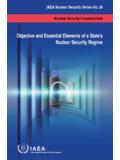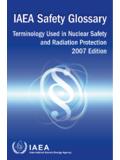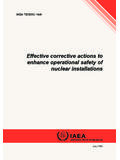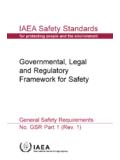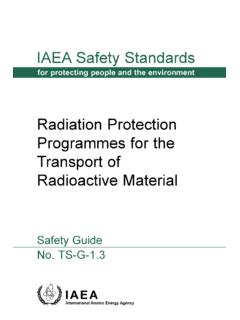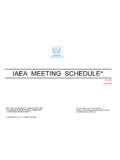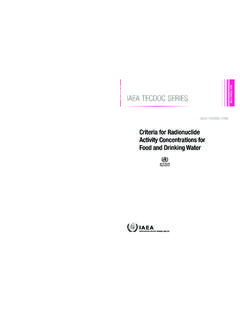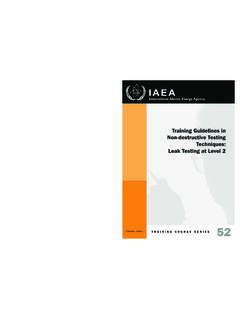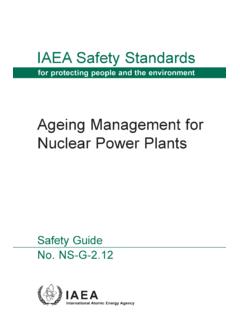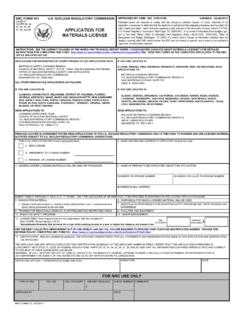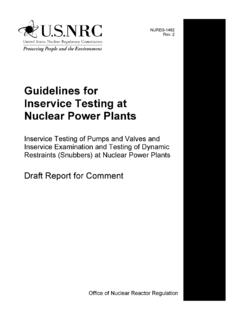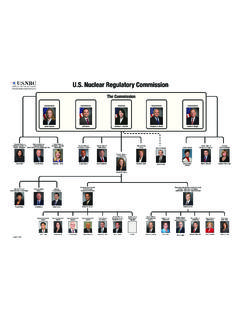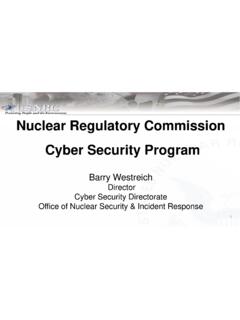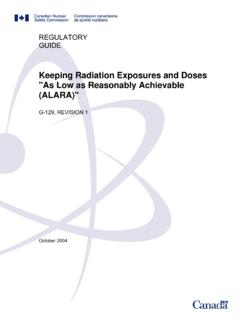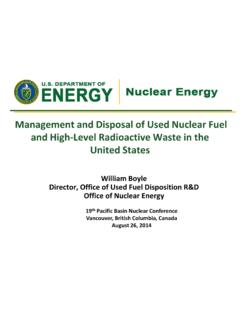Transcription of IAEA Safety Standards
1 INTERNATIONAL ATOMIC ENERGY AGENCYVIENNAISBN 978 92 0 100409 3 ISSN 1020 525X The IAEA s Standards have become a key element of the global Safety regime for the beneficial uses of nuclear and radiation related technologies. IAEA Safety Standards are being applied in nuclear power generation as well as in medicine, industry, agriculture, research and education to ensure the proper protection of people and the environment. Mohamed ElBaradeiIAEA Director GeneralSafety through international standardsIAEA Safety StandardsEvaluation of Seismic Safety for Existing Nuclear Installationsfor protecting people and the environmentNo. Guide84 pages, 12009-05-22 14:24:19 EVALUATION OFSEISMIC Safety FOR EXISTINGNUCLEAR INSTALLATIONSS afety Standards survey The IAEA welcomes your response.
2 Please see: following States are Members of the International Atomic Energy Agency:The Agency s Statute was approved on 23 October 1956 by the Conference on the Statute of the IAEA held at United Nations Headquarters, New York; it entered into force on 29 July 1957. The Headquarters of the Agency are situated in Vienna. Its principal objective is to accelerate and enlarge the contribution of atomic energy to peace, health and prosperity throughout the world .AFGHANISTANALBANIAALGERIAANGOLAARGENTIN AARMENIAAUSTRALIAAUSTRIAAZERBAIJANBANGLA DESHBELARUSBELGIUMBELIZEBENINBOLIVIABOSN IA AND HERZEGOVINABOTSWANABRAZILBULGARIABURKINA FASOCAMEROONCANADACENTRAL AFRICAN REPUBLICCHADCHILECHINACOLOMBIACOSTA RICAC TE D IVOIRECROATIACUBACYPRUSCZECH REPUBLICDEMOCRATIC REPUBLIC OF THE CONGODENMARKDOMINICAN REPUBLICECUADOREGYPTEL SALVADORERITREAESTONIAETHIOPIAFINLANDFRA NCEGABONGEORGIAGERMANYGHANAGREECEGUATEMA LAHAITIHOLY SEEHONDURASHUNGARYICELANDINDIAINDONESIAI RAN, ISLAMIC REPUBLIC OF IRAQIRELANDISRAELITALYJA M A I CAJA PANJORDANKAZAKHSTANKENYAKOREA.
3 REPUBLIC OFKUWAITKYRGYZSTANLATVIALEBANONLIBERIALI BYAN ARAB JAMAHIRIYALIECHTENSTEINLITHUANIALUXEMBOU RGMADAGASCARMALAWIMALAYSIAMALIMALTAMARSH ALL ISLANDSMAURITANIAMAURITIUSMEXICOMONACOMO NGOLIAMONTENEGROMOROCCOMOZAMBIQUEMYANMAR NAMIBIANEPAL NETHERLANDSNEW ZEALANDNICARAGUANIGERNIGERIANORWAYOMANPA K I S TA NPALAUPA NA M APA R AG UAYPERUPHILIPPINESPOLANDPORTUGALQATARREP UBLIC OF MOLDOVAROMANIARUSSIAN FEDERATIONSAUDI ARABIASENEGALSERBIASEYCHELLESSIERRA LEONESINGAPORESLOVAKIASLOVENIASOUTH AFRICASPAINSRI LANKASUDANSWEDENSWITZERLANDSYRIAN ARAB REPUBLICTAJIKISTANTHAILANDTHE FORMER YUGOSLAV REPUBLIC OF MACEDONIATUNISIATURKEYUGANDAUKRAINEUNITE D ARAB EMIRATESUNITED KINGDOM OF GREAT BRITAIN AND NORTHERN IRELANDUNITED REPUBLIC OF TANZANIAUNITED STATES OF AMERICAURUGUAYUZBEKISTANVENEZUELAVIETNAM YEMENZAMBIAZIMBABWEEVALUATION OFSEISMIC Safety FOR EXISTINGNUCLEAR INSTALLATIONSI N T E R NAT I O NA L ATO M I C E NE RG Y AG E N C YVIENNA, 2009 IAEA Safety Standards SERIES No.
4 Library Cataloguing in Publication DataEvaluation of seismic Safety for existing nuclear installations. Vienna : International Atomic Energy Agency, ; 24 cm. (IAEA Safety Standards series, ISSN 1020 525X ; no. )STI/PUB/1379 ISBN 978 92 0 100409 3 Includes bibliographical Nuclear power plants Earthquake effect. 2. Nuclear facilities Design and construction. 3. Earthquake resistant design. I. International Atomic Energy Agency. II. 00577 COPYRIGHT NOTICEAll IAEA scientific and technical publications are protected by the terms of the Universal Copyright Convention as adopted in 1952 (Berne) and as revised in 1972 (Paris). The copyright has since been extended by the World Intellectual Property Organization (Geneva) to include electronic and virtual intellectual property.
5 Permission to use whole or parts of texts contained in IAEA publications in printed or electronic form must be obtained and is usually subject to royalty agreements. Proposals for non-commercial reproductions and translations are welcomed and considered on a case-by-case basis. Enquiries should be addressed to the IAEA Publishing Section at: Sales and Promotion, Publishing SectionInternational Atomic Energy AgencyWagramer Strasse 5P. O . B o x 1 0 01400 Vienna, Austriafax: +43 1 2600 29302tel.: +43 1 2600 22417email: IAEA, 2009 Printed by the IAEA in AustriaMay 2009 STI/PUB/1379 FOREWORDby Mohamed ElBaradeiDirector GeneralThe IAEA s Statute authorizes the Agency to establish Safety Standards to protect health and minimize danger to life and property Standards which the IAEA must use in its own operations, and which a State can apply by means of its regulatory provisions for nuclear and radiation Safety .
6 A comprehensive body of Safety Standards under regular review, together with the IAEA s assistance in their application, has become a key element in a global Safety the mid-1990s, a major overhaul of the IAEA s Safety Standards programme was initiated, with a revised oversight committee structure and a systematic approach to updating the entire corpus of Standards . The new Standards that have resulted are of a high calibre and reflect best practices in Member States. With the assistance of the Commission on Safety Standards , the IAEA is working to promote the global acceptance and use of its Safety Standards are only effective, however, if they are properly applied in practice.
7 The IAEA s Safety services which range in scope from engineering Safety , operational Safety , and radiation, transport and waste Safety to regulatory matters and Safety culture in organizations assist Member States in applying the Standards and appraise their effectiveness. These Safety services enable valuable insights to be shared and I continue to urge all Member States to make use of nuclear and radiation Safety is a national responsibility, and many Member States have decided to adopt the IAEA s Safety Standards for use in their national regulations. For the contracting parties to the various international Safety conventions, IAEA Standards provide a consistent, reliable means of ensuring the effective fulfilment of obligations under the conventions.
8 The Standards are also applied by designers, manufacturers and operators around the world to enhance nuclear and radiation Safety in power generation, medicine, industry, agriculture, research and IAEA takes seriously the enduring challenge for users and regulators everywhere: that of ensuring a high level of Safety in the use of nuclear materials and radiation sources around the world. Their continuing utilization for the benefit of humankind must be managed in a safe manner, and the IAEA Safety Standards are designed to facilitate the achievement of that IAEA Safety STANDARDSBACKGROUNDR adioactivity is a natural phenomenon and natural sources of radiation are features of the environment. Radiation and radioactive substances have many beneficial applications, ranging from power generation to uses in medicine, industry and agriculture.
9 The radiation risks to workers and the public and to the environment that may arise from these applications have to be assessed and, if necessary, such as the medical uses of radiation, the operation of nuclear installations, the production, transport and use of radioactive material, and the management of radioactive waste must therefore be subject to Standards of Safety is a national responsibility. However, radiation risks may transcend national borders, and international cooperation serves to promote and enhance Safety globally by exchanging experience and by improving capabilities to control hazards, to prevent accidents, to respond to emergencies and to mitigate any harmful have an obligation of diligence and duty of care, and are expected to fulfil their national and international undertakings and Safety Standards provide support for States in meeting their obligations under general principles of international law, such as those relating to environmental protection.
10 International Safety Standards also promote and assure confidence in Safety and facilitate international commerce and global nuclear Safety regime is in place and is being continuously improved. IAEA Safety Standards , which support the implementation of binding international instruments and national Safety infrastructures, are a cornerstone of this global regime. The IAEA Safety Standards constitute a useful tool for contracting parties to assess their performance under these international IAEA Safety STANDARDSThe status of the IAEA Safety Standards derives from the IAEA s Statute, which authorizes the IAEA to establish or adopt, in consultation and, where appropriate, in collaboration with the competent organs of the United Nations and with the specialized agencies concerned, Standards of Safety for protection of health and minimization of danger to life and property, and to provide for their a view to ensuring the protection of people and the environment from harmful effects of ionizing radiation.
